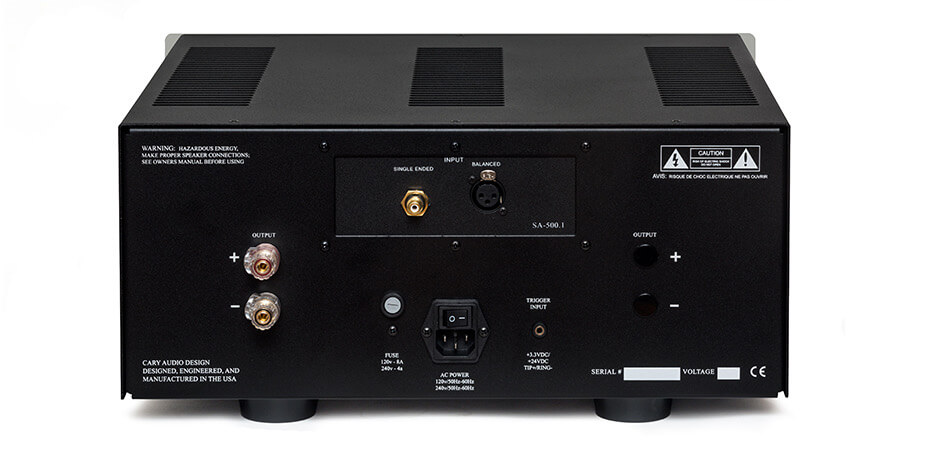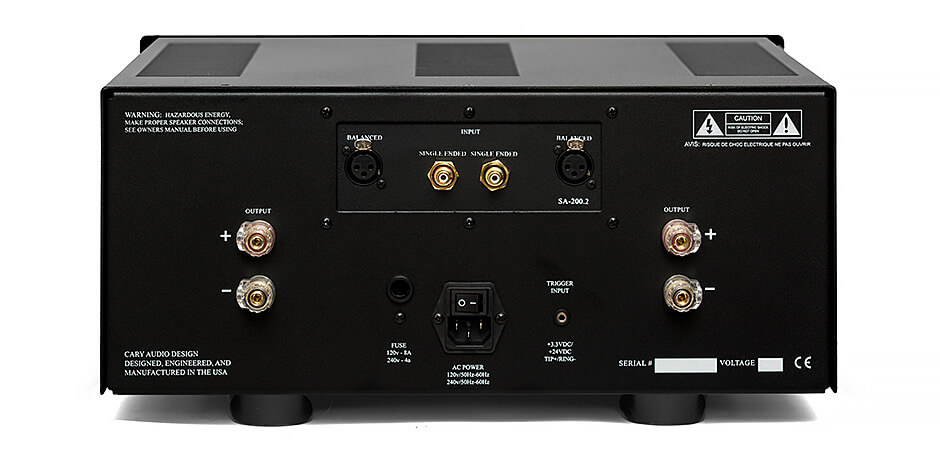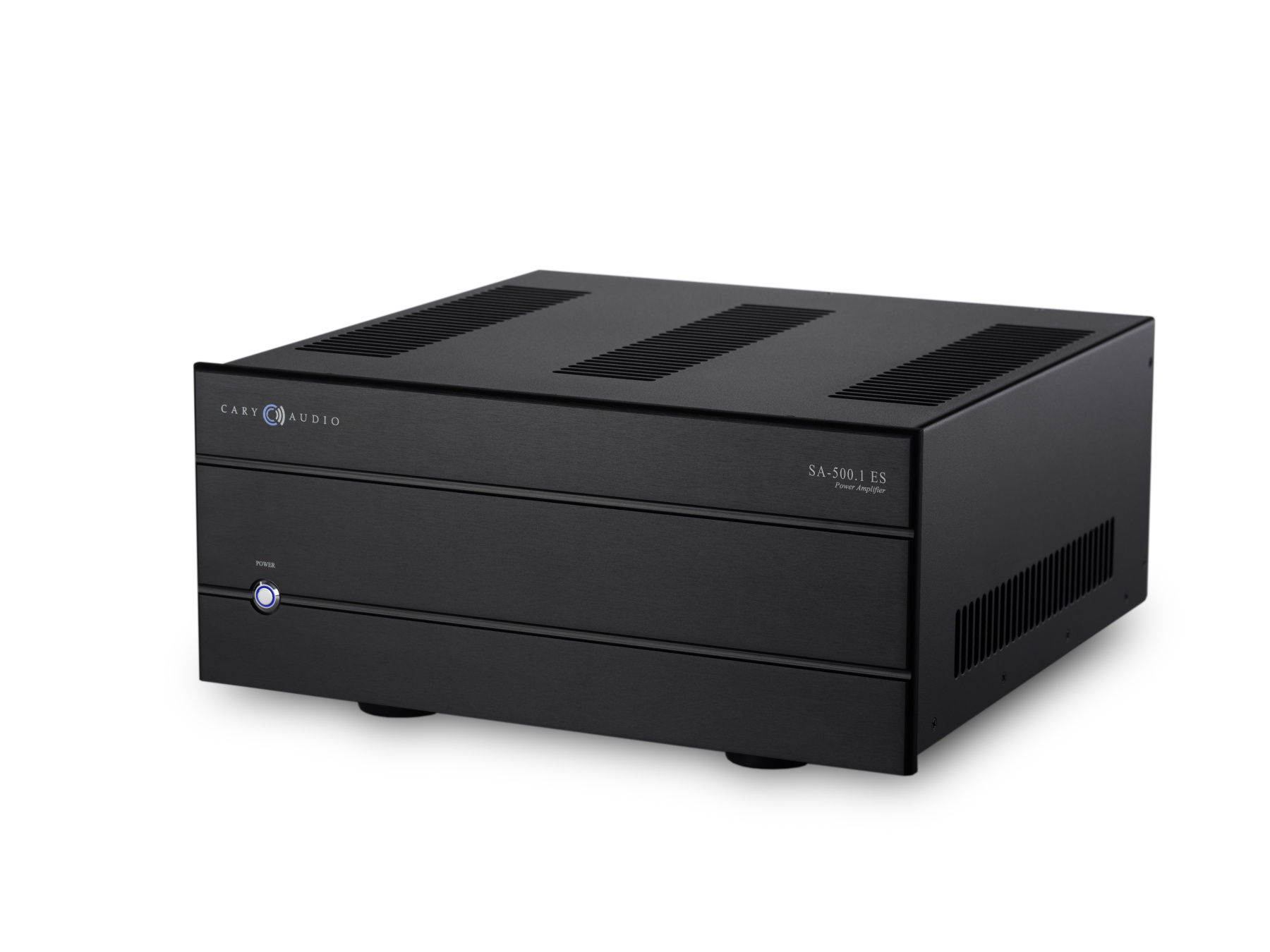OVERVIEW
The introduction of the original SA-200.2 and SA-500.1 solid-state amplifiers represented a departure from traditional Cary Audio amplifier design and was a clean sheet design from the ground up. They embodied a new modular approach that ensured consistency in performance, and ease of manufacture and serviceability. In
implementing the new design, we dramatically improved performance and current-handling capacity over previous models while still maintaining the highest levels of sonic quality. The new SA-200.2 ES and SA-500.1 ES amplifiers represent the next generation
of these high-performance amplifiers. Like other Cary Audio products, these amplifiers are designed and built at our factory in North Carolina.
BACKGROUND
Cary Audio has been in the forefront of vacuum tube amplification for over a quarter of a century, and over the past twenty or so years branched out into solid-state and digital audio. The SA-200.2 ES and SA-500.1 ES are our latest offerings and are fully in keeping with our proud heritage. The SA-200.2 ES is a 200 watts per channel stereo amplifier (into 8 ohms, 350 w/channel into 4 ohms) with both balanced and single-ended inputs. The SA-500.1 ES is a 500 watts per channel mono-block amplifier (into 8 ohms, 1000 watts into 4 ohms), and is essentially a bridged SA-200.2 ES with a balanced or single ended input. Both models exhibit very high current capability, are stable into low impedance loads, and feature 3dB of dynamic headroom.
DESIGN PHILOSOPHY
Dependability When we designed this amplifier one of our primary goals was to create a product that would give years of consistent and reliable use without any maintenance. To achieve that goal, we took a hard look at the design and choice of components. For example, we use high-precision metal film resistors in almost all our circuitry, even in places where their use is not required. We have overbuilt the output stage and increased the heat dissipating capabilities of the amplifiers by as much as 50% over our previous
designs. The changes encompass almost every part of the design, down to the choice of thickness of the chassis sheet metal. The monolithic front end brought major advantages to the amplifier design with improved temperature stability, low offset, and a substantial reduction of all types of distortion across the full frequency spectrum.

Sonic Quality
Cary Audio has been known for over a quarter of a century as a producer of some of the finest and most musical tube amplifiers in the world. Based on this heritage we have paid special attention to the sonic qualities of these new generation solid-state amplifiers, voicing them to have the proven attributes of the “Cary Sound” and testing them hundreds of hours with many different speakers. In our quest to dramatically improve them over our previous efforts we compared them to some of the best of the competition, often at much higher price points. This took months of research and development but we would not rest until we were satisfied that we had surpassed our previous models by a wide margin. The improvements in the power supply have brought gains in bass performance, which is now much more visceral and controlled even into difficult loads. Reducing the noise floor, increasing the isolation between the channels, and especially redesigning the sensitive front end of the amplifier has improved imaging, sound staging and depth retrieval. The midrange is now more lifelike and palpable. One area of which we are particularly proud is what we have achieved in transparency, and the way images now hang in three-dimensional space. The amplifiers were designed to be equally at home in a high-performance music system or a home
cinema setting.
Flexibility
One of our major goals and challenges was to improve the flexibility of the design. What are we talking about when we say flexibility? In this case we mean ease of manufacture and service, and the ability to perform upgrades in a cost-effective manner. We decided to take a modular approach with this new design, allowing us to more efficiently build the amplifiers and reducing potential service time to a fraction of what it used to be by making it possible to simply field-replace a defective module. Each module and board is a self-contained entity, and should service or an upgrade be required it is as simple as removing the amplifier’s top cover and replacing the module without affecting the rest of the amplifier. This philosophy will reflect in our future designs and products.

FEATURES
• Overbuilt Power Supply. These amplifiers employ a massive 850VA low-noise toroidal transformer with separate windings for the regulated input board. This transformer was custom manufactured for us by a manufacturer of high-performance toroids.
The SA-500.1 ES amplifier employs in excess of 98,000uF of capacitance per channel. The SA-200.2 ES employs in excess of 57,000 uF of capacitance per channel. This is much more than most comparable designs. Power supplies are often neglected and designed to meet a minimum specification. In truth, the power supply can contribute to almost half of the sonic signature of an amplifier, so we paid a great deal of attention to its performance.
• The input stage is designed around a monolithic device that ensures extremely low distortion, low offset voltage and emperature stability. The device is attached to a custom heat sink and extreme care is taken in bypassing and isolating its power supply. All traces on the printed circuit board are kept extremely short to reduce noise and distortion. A ground plane is used around sensitive components to further reduce noise pick up.
• The power supply capacitors reside on the amplifier boards where they can do the most good. We went a step further by adding bypass capacitors right at the output devices themselves. Our research showed us that reducing the distance between the power supply capacitors and the amplifier circuitry produced substantial sonic gains. Large capacitors suffer from several problems including higher ESR (Equivalent Series Resistance) and diminished high frequency performance. We got around this issue by using multiple smaller high-quality capacitors.
• Each chassis uses sixteen high current 150-watt bipolar output devices chosen for their reliability and performance, which ensures the amplifier’s stability into difficult loads. To keep this passive stage cool we designed a new heat sink with a larger radiating surface and fin structure.
• Passive components like resistors and capacitors can have a huge effect on the sound of an amplifier and we spared no expense where it was warranted. Extensive listening tests were employed in selecting these components.
• The amplifiers are designed on a modular concept and can be disassembled quite easily, in the unlikely event a service issue should arise. The modular approach has allowed us to improve the consistency and reliability of these products. The circuitry of each amplifier resides on four easily-replaceable fiberglass printed circuit boards.
• These amplifiers employ thermal as well as DC-offset protection. We do not use traditional voltage and current limiting as they can adversely affect the sound under demanding drive conditions. Our protection circuitry is totally non-invasive and employs a simple high-current relay to disconnect the speakers should a fault condition arise.

Our goals in designing these new amplifiers were quite extensive, and we believe we met or exceeded all of them. As a company we strive to be on the cutting edge of our industry, which requires a lot of research and dedication on our part to bring you the best products possible. We are confident that the SA-200.2 ES and SA-500.1 ES are superb amplifiers that will meet the tests of musical accuracy, dynamic performance,and long-term reliability.





